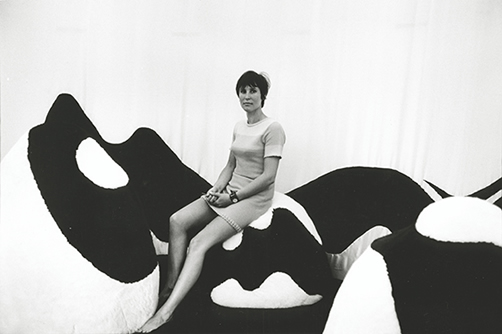
Maria van Elk
'The artist Maria van Elk has, at the request of the 'Stedelijk Museum Schiedam', made an exact copy of the installation The Soft Living Room. This is a sculpture with which the artist already in 1968 investigated new possibilities.'
quotation 'Stedelijk Museum Schiedam'
No longer on exhibition in the Stedelijk Museum Schiedam, The Netherlands

dimensions
Diameter 4 meter, height 2 meter
sculpture
Interior: abstract spatial landscape with 8 movable hills enclosed by a 16 angular space.
The light is filtered by the white roof of artificial silk. The soft floor is coverd with black artificial fur.
colour
Black and white
material
Artificial fur, foam, artificial silk and wood
photo
Erling Mandelmann, Switserland, 1969
| MARIA VAN ELK: 'The Soft Living Room is a spatial landscape originated from contemplating the illusionary side of the two dimensional landscape. You can never enter a painting, but you can enter The Soft Living Room.' |
At the request of the 'Stedelijk Museum Schiedam' the artist Maria van Elk (Amsterdam, 1943) has reconstructed the installation The Soft Living Room. This is a sculpture with which the artist in 1968 was investigating new possibilities for the interaction between her work and the public. The Soft Living Room is an abstract spatial landscape that can be entered by visitors and that contains a number of movable hills. The black and white planes and forms express notions of harmony and conflict, good and evil, extremes which cannot exist without each another. It is a social sculpture not only to make art more accessible, but was also ment to improve the interrelations between people. Notwithstanding the substantial international success at the time (1968) this unique sculpture has passed into oblivion. Now it will, thanks to the exceptional efforts of the artist, and also to a private sponsor, be possible again to view this sculpture for the first time since 1969 in the exhibition Ik hou van Holland. Nederlandse beeldende kunst na 1945. The Soft Living Room, 1968 16 angular space | diameter 4 meter | height 2 meter wood | foam | artificial fur | artificial silk collection 'Stedelijk Museum Schiedam' www.stedelijkmuseumschiedam.nl/en/ |
'A superb rediscovery from the sixties. The artist Maria van Elk has, at the request of the 'Stedelijk Museum Schiedam', made an exact copy of the installation The Soft Living Room. This is a sculpture with which the artist already in 1968 investigated new possibilities.' Reconstruction Soft Living Room 2013 (foto: Colin Huizing) The Soft Living Room is now on exhibition during the presentation of the collection of the 'Stedelijk Museum Schiedam': Ik hou van Holland. Nederlandse beeldende kunst na 1945 (I love Holland. Dutch post-war art). September 21, 2013 - September 6, 2015 |
 |
 |
 |
click on the pictures to enlarge
The card is accompanied by a series of two unique stamps showing the original Soft Living Room from 1968..
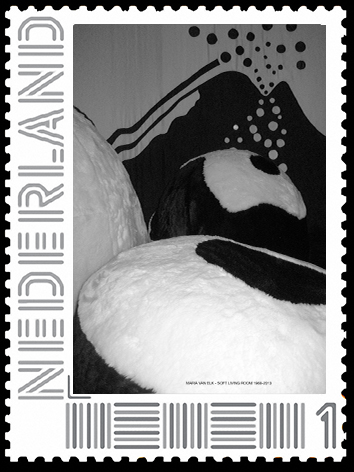 |
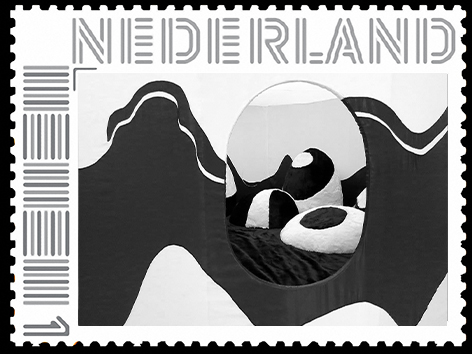 |
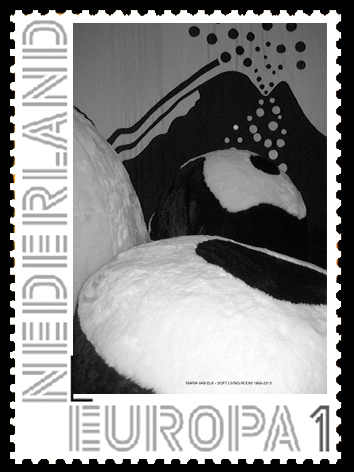 |
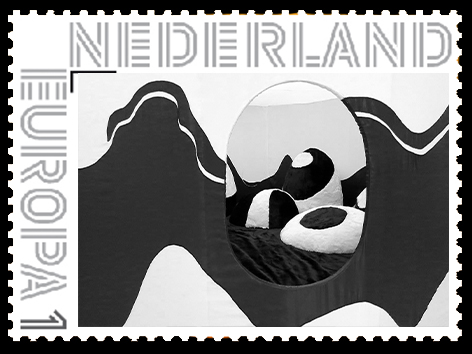 |
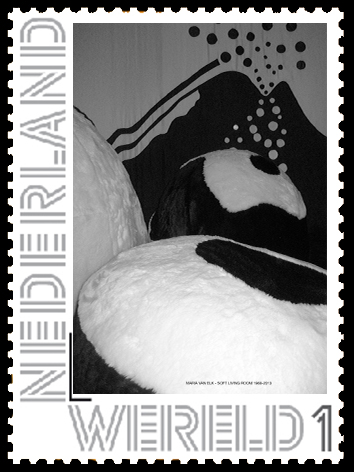 |
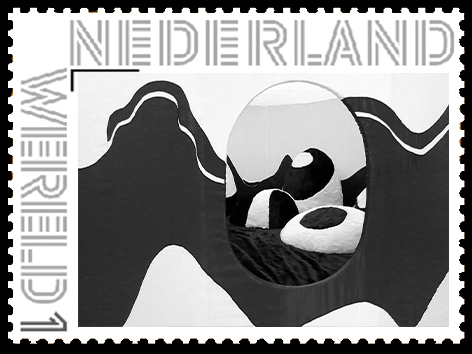 |
|---|
On the occasion of the 2013 reconstruction of the Soft Living Room Maria van Elk has made an unique multiple.
edition
25
material
Synthetic fur and artificial silk
date
March 29, 2013.
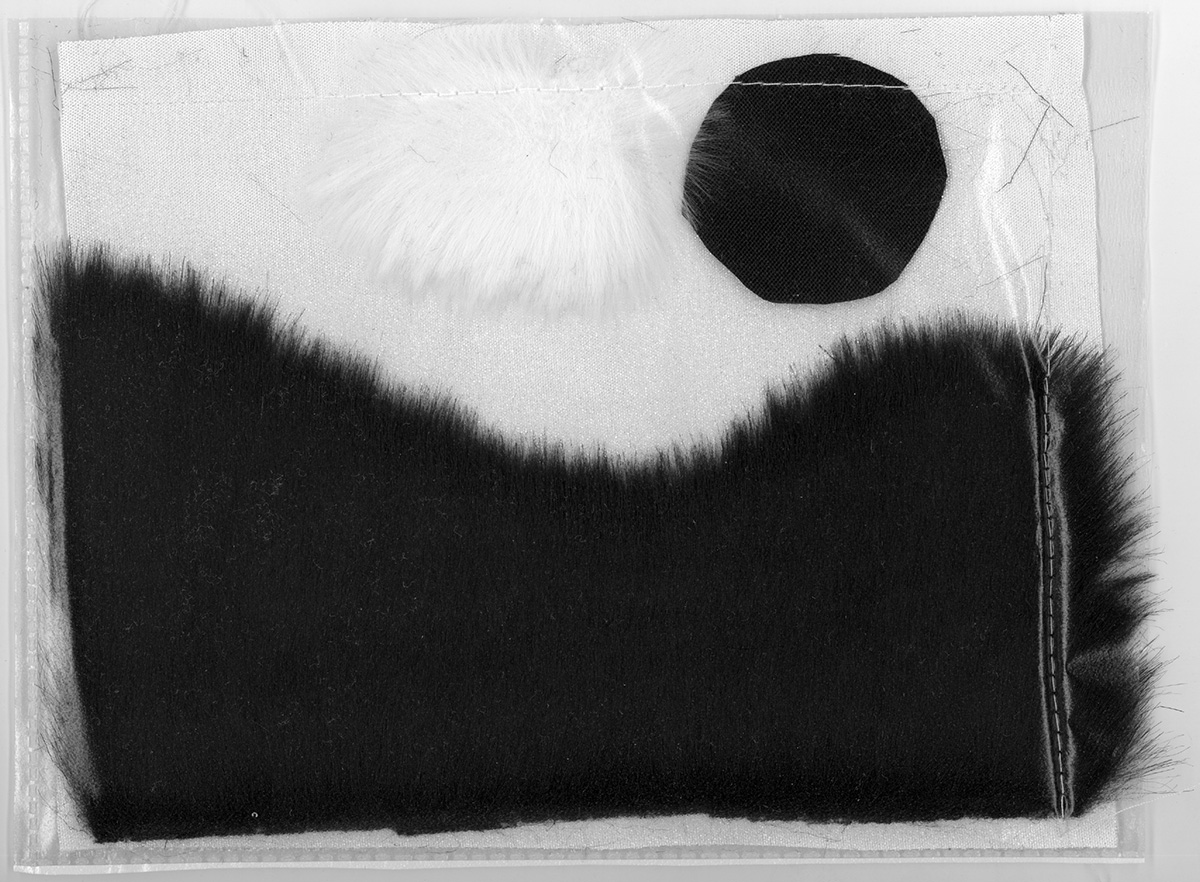 |
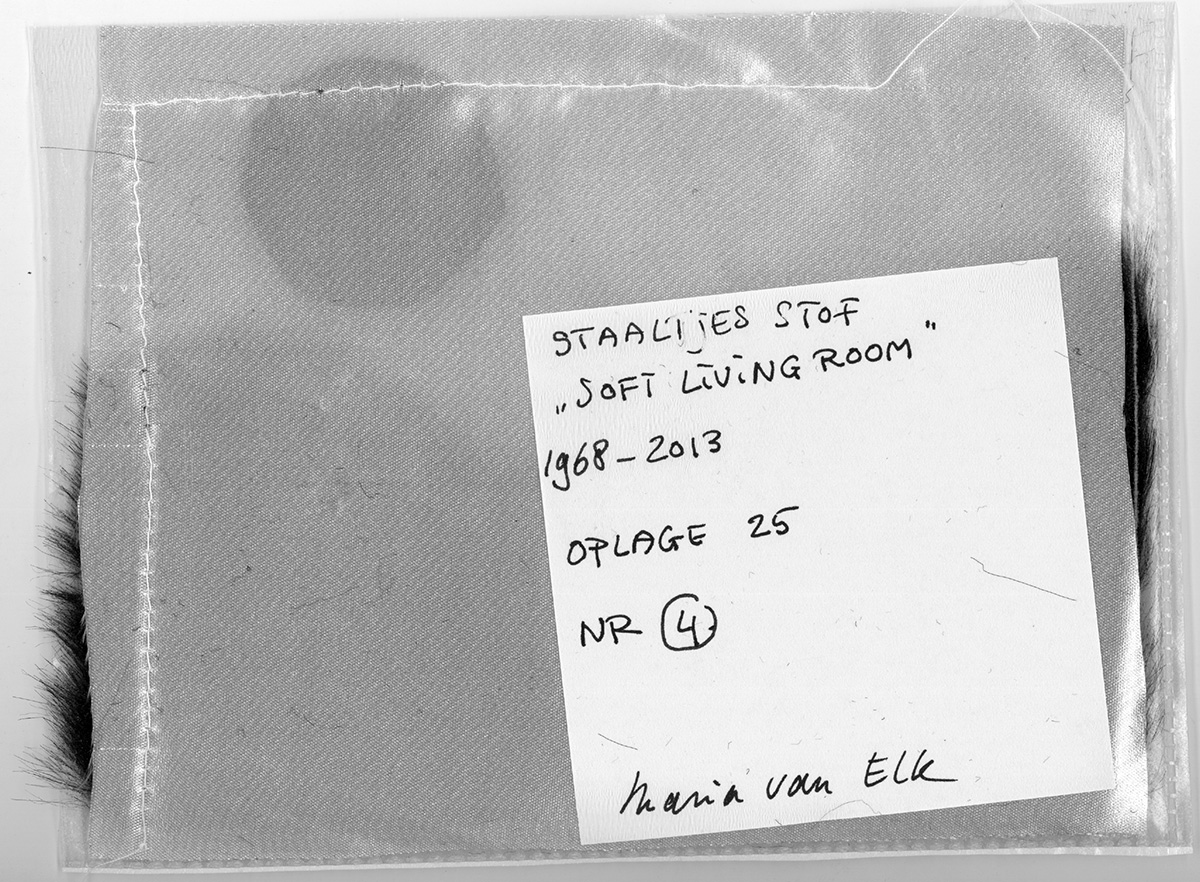 |
|---|
SOFT LIVING ROOM 1967-2013
With pleasure I invite you on a journey back in time, to rest awhile in the Soft Living Room of 1969. This work is, after being hidden for more than 40 years, now again on display in the Stedelijk Museum Schiedam as part of the exhibition 'Ik hou van Holland', until September 6th 2015.
1967 In 1967 I made the first Soft Living Room (SLR) for display in the 'Hallen' in Haarlem. It comprised a space of ± 5 meters diameter, enclosed by dark blue material. On this dark blue material a landscape was pictured in, amongst other materials, fluorescent non-artistic colours. Dark blue hills filled with foam flakes were placed in the space. The whole installation was lit with small bulbs that, like the stars at night, gave the colours an extra glow. After the exhibition Willem de Ridder (Hitweek) asked me if he could move the installation to Fantasio, a youth centre on the Prins Hendrikkade. The SLR would be used as a playful space in which one could drink herbal tea, listen to music, relax, amplify the mind and meditate. We transported the SLR to Fantasio in Willem's old car. After a time this work disappeared without a trace. 1968 Benno Premsela asked me, as a result of the first SLR (1967), to make a large installation for the biennale in Lausanne (Switzerland). Enabled by a subsidy for materials, a travel subsidy from the Ministry of Culture, and a studio temporarily made available by the Stedelijk Museum Amsterdam, I realized a work of art that was large for the time. For this second piece I was able to work in a more suitable studio and with better materials, like artificial fur, solid foam, artificial silk and block board. 1969 The Soft Living Room that resulted has a diameter of four meters. The height of the wall is two meters and is constructed from 16 wooden panels that together form an enclosed space based on a perfect circle. The floor is shaped from 15cm thick foam and is completely covered with black artificial fur. Inside the SLR are eight moveable sculptures; each one comprising a hill of foam covered with artificial fur. The wave motif is continued from the walls to the sculptures to create an interaction between the two-dimensional nature of the walls and the three-dimensional aspect of the sculptures. The colours used in the piece are limited to black and white, to create contrast and extremes. The black, heavy and dark floor extends upward to the white light filtered in by the white roof of artificial silk that seals the inside from the outside world. A small oval hole is the only entrance to the SLR. In the 1960s one tried to achieve lightness and timelessness by means of meditation. The SLR was designed as a soft landscape into which one could disappear from a turbulent society where many things were being questioned and many boundaries pushed aside; a turbulent society within which violence and aggression were common and equal rights for men and women were being claimed; a society within which the distance between exclusive art and the public was diminishing. In the summer of 1969 Lysander Apol and Art van Westerop transported the SLR to the biennale in Lausanne (Switzerland). In Lausanne the SLR was a spectacular success. The journalist Virtus Schade wrote in the Danish newspaper Berlingske Aftenavis (June 18th 1969) that: 'One has to take ones shoes off before the art can be experienced. No this is not a happening, but a serious art exhibition. The work of Maria van Elk has to be reviewed as the most advanced.' 1970 1971 1972 Following exhibitions in the Department of Architecture at the Eindhoven University of Technology and in the 'Vishal' in Haarlem, the voyage of the SLR ended at the Stedelijk Museum Schiedam, after which it disappeared, or so it seemed. 1998 Until I received a letter in 1998 from Ludo van Halem, the then curator of the visual arts at the museum in Schiedam, telling me that he had discovered remnants of the Soft Living Room in an attic of the municipality of Schiedam. I was invited to assist with the restoration of the SLR, but this was an impossible task for me at that time. 2013 It was not until the beginning of 2013 that Colin Huizing and Christel Kordes invited me, on behalf of the Stedelijk Museum Schiedam to make a complete reconstruction of the SLR. Due to their enthusiasm, and also due to the support of An and Martin de Voigt, I gathered enough courage to save a work of art from ruin that I had made 45 years ago. With the help of the following people the Soft Living Room is again as it used to be: An and Martien de Voigt gave moral and financial support. Colin Huizing organized swiftly, energetically and decisively the necessary materials, the atelier and the transport of the SLR to Schiedam. Erik Bouma, Aad Jongkind, Rens van Vuuren en Roelie Zijlstra made the 16 wall panels, and assisted with the transport and the erection of the SLR in Schiedam. Eva Damave, Irene and Jeff Carroll, Deborah Apol and Sieb Bohlken assisted with miscellaneous activities. Evert de Cock made a computer reconstruction of the wall design from a handful of old pictures and attended to print work. Christel Kordes made diagrams, a description and exact measurement of the hills of the 1969 SLR without which the reconstruction of the SLR would have been impossible. Thea van Oosten from the "Instituut Collectie Nederland" made a quick analysis of the materials used in the original SLR based on what was left of the 1968 SLR so that I could order exactly the same quality of foam and artificial fur for the reconstruction. The contributions of these people ensured the success of the reconstruction and that the Soft Living Room is again on exhibition in Schiedam! Maria van Elk, 2013 |
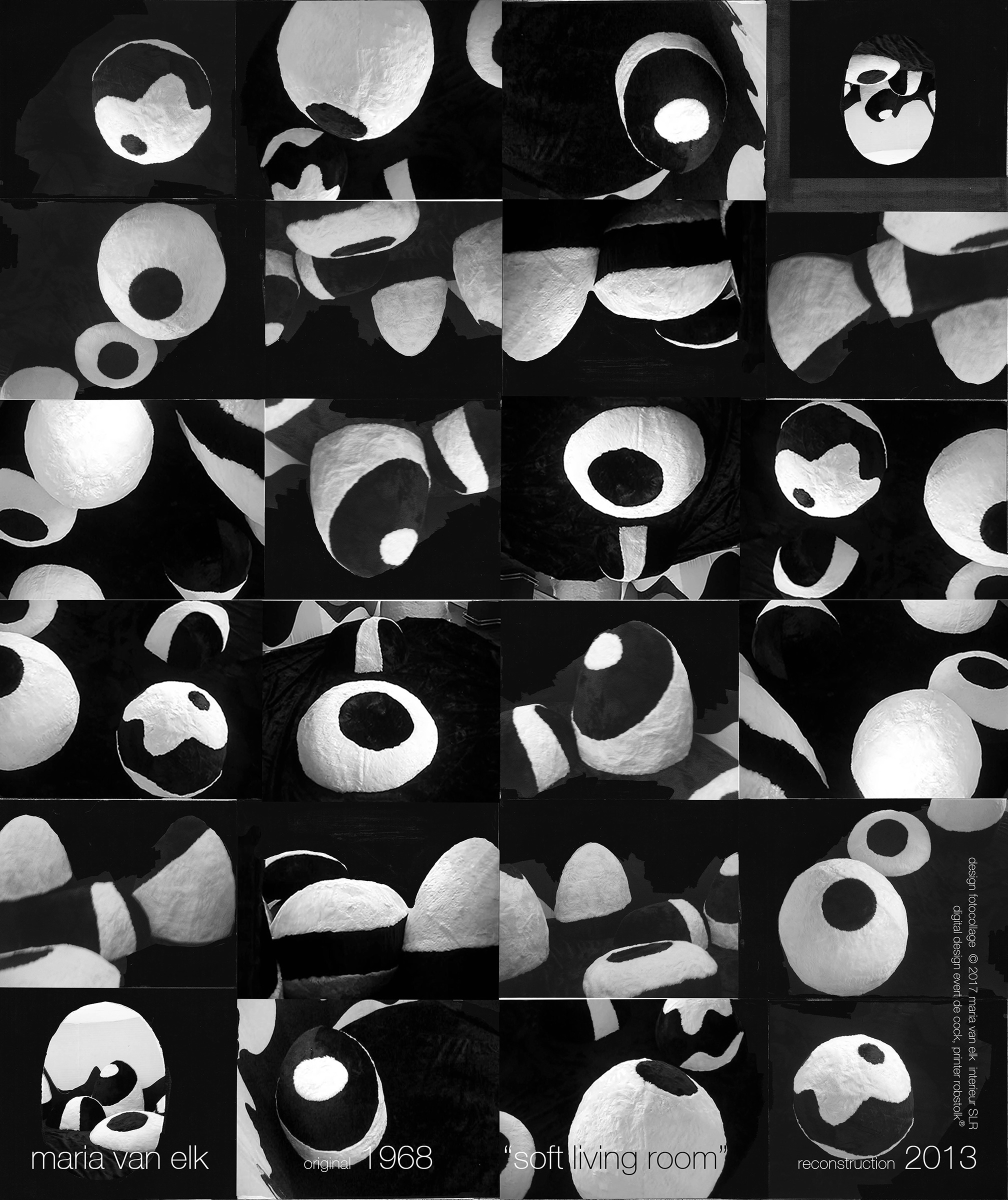 |
This poster is accompagied by a unique post stamp. The picture shows in birds-eye view the position of the hills on the floor of the original Soft Living Room (1968).
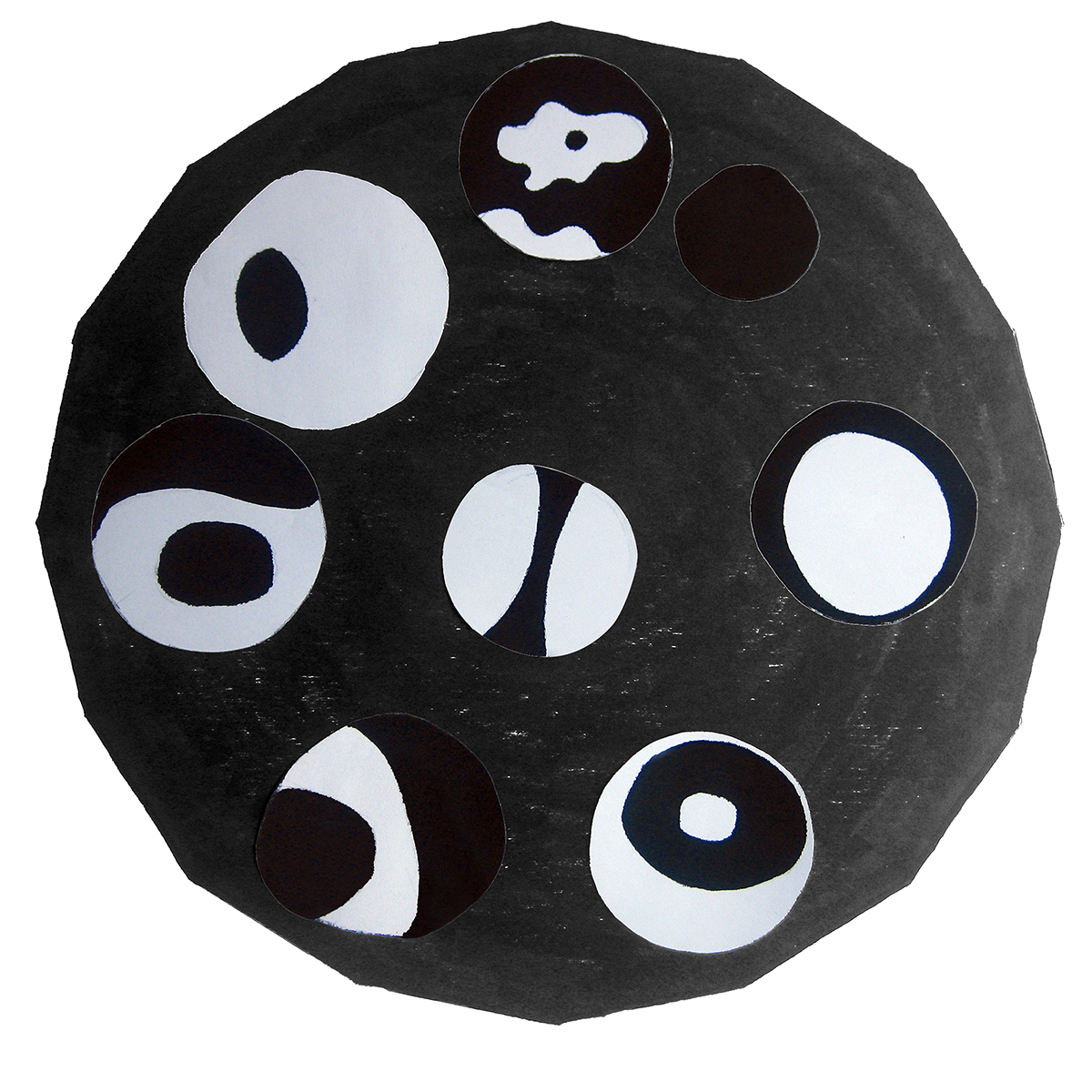
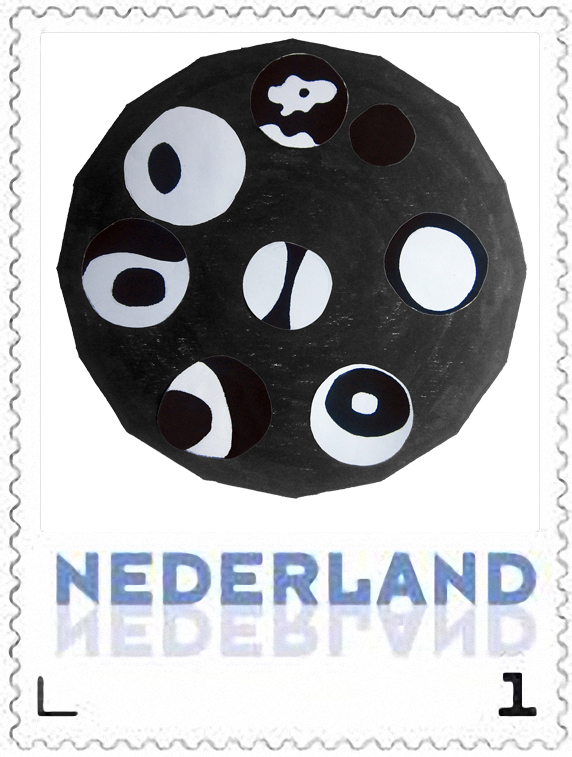 |
 |
Maria van Elk: 1968 ... 2013 Soft Living Room
Private edition (2017)
click here to view the book full screen